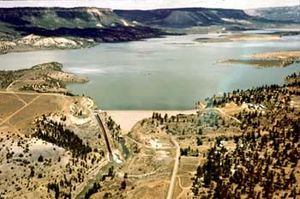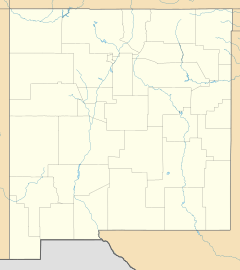El Vado Dam facts for kids
Quick facts for kids El Vado Dam |
|
|---|---|
 |
|
|
Location of El Vado Dam in New Mexico
|
|
| Country | United States |
| Location | Rio Arriba County, New Mexico |
| Coordinates | 36°35′41″N 106°43′58″W / 36.59472°N 106.73278°W |
| Owner(s) | U.S. Bureau of Reclamation |
| Dam and spillways | |
| Type of dam | Earthfill |
| Impounds | Rio Chama |
| Height | 229.5 ft (70.0 m) |
| Length | 1,326 ft (404 m) |
| Dam volume | 608,000 cu yd (465,000 m3) |
| Spillways | 2x |
| Spillway type | Concrete overflow, service |
| Spillway capacity | 17,800 cu ft/s (500 m3/s) |
| Reservoir | |
| Creates | El Vado Lake |
| Total capacity | 196,500 acre⋅ft (242,400,000 m3) |
| Catchment area | 492 sq mi (1,270 km2) |
| Surface area | 3,200 acres (1,300 ha) |
| Maximum water depth | 167.1 ft (50.9 m) |
| Power station | |
| Installed capacity | 8 MW |
El Vado Dam is a large structure built across the Rio Chama river in New Mexico, United States. It is located about 105 miles (169 km) northwest of Albuquerque and 80 miles (129 km) northwest of Santa Fe. This dam is made mostly of earth and rock, and it creates a big lake called El Vado Lake. The lake stores water for an important project called the Middle Rio Grande Project.
Contents
Building the Dam
El Vado Dam was first built to store water for irrigation. Irrigation means supplying water to farms and fields. The water was needed for the Middle Rio Grande Basin, a large area in New Mexico.
Original Construction (1933-1935)
Work on the dam started in 1933 and was finished in 1935. By 1936, the lake behind the dam was full. This new lake covered the town of El Vado, which was the biggest town in Rio Arriba County. The town's name, "El Vado," means "the crossing" in Spanish. It was an important place for crossing the Rio Chama river and for trading goods in the 1800s.
Dam Upgrades and Changes
The dam was repaired and improved by the Bureau of Reclamation in 1954 and 1955. Later, in the 1960s and 1970s, a new project called the San Juan-Chama Project brought more water to the Rio Chama. This project built a tunnel to move water from the San Juan River basin to the Rio Chama.
Because of this extra water, the dam's water release system needed to be made bigger. Between 1965 and 1966, the outlet works (the pipes and gates that release water) at El Vado Dam were enlarged. This allowed more water to pass through the dam, especially water coming from the new Heron Dam. The outlet works can now release up to 6,600 cubic feet (187 cubic meters) of water per second.
Dam Structure and Size
El Vado Dam is a very large structure. It stands about 229.5 feet (70 meters) high and stretches 1,326 feet (404 meters) long. The dam can hold a huge amount of water, about 196,500 acre-feet (242 million cubic meters).
Water Release Systems
The dam has a special concrete spillway. A spillway is like a giant overflow channel that lets excess water flow safely past the dam. This spillway can release up to 17,800 cubic feet (504 cubic meters) of water per second. The dam also has other outlet works that can release about 6,850 cubic feet (194 cubic meters) of water per second.
What the Dam is Used For
El Vado Dam is owned by the United States Bureau of Reclamation. It has two main jobs: storing water and helping to control floods.
Generating Electricity
The dam also has a power plant that can make 8 megawatts of electricity. This power plant is owned by the Los Alamos Department of Public Utilities.
Recreation at El Vado Lake
The lake created by the dam, El Vado Lake, covers about 3,200 acres (1,295 hectares). The area around the lake is part of El Vado Lake State Park. It's a popular spot for people to go swimming, fishing, and boating.


